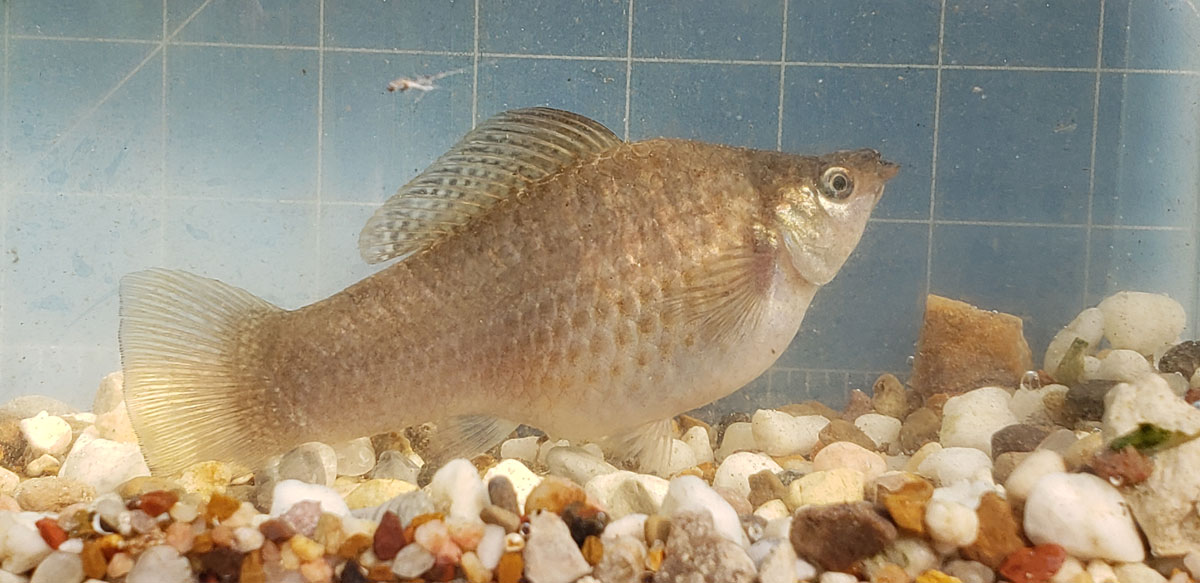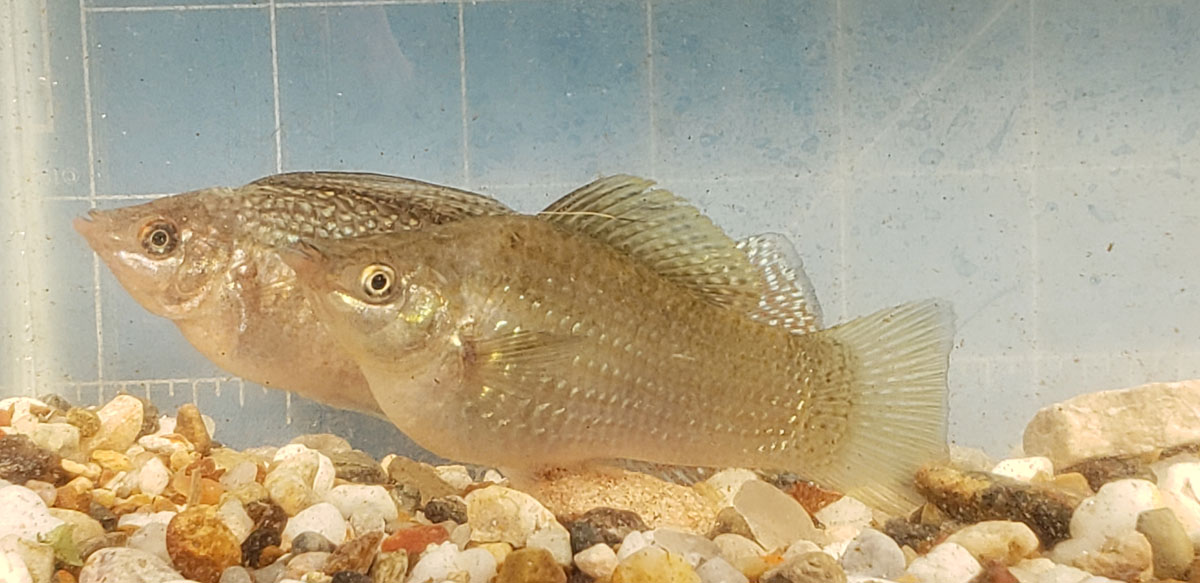Photo: A large male Green Sailfin Molly from four years ago and one of our breeders used in our attempt to create a giant molly.
For about eight years, I’ve been working to develop a very large Green Sailfin Molly, which I creatively named Giant Green Sailfin Mollies (“GGSM” for short for the rest of this blog). Catchy, right? I have a real knack for naming fish.
While Hurricane Harvey and its aftermath set back most of our molly breeding programs, four of our experimental GGSM breeding colonies survived. They suffered losses, but nothing like our Poecilia species sailfin mollies (those of you who subscribe to our newsletter got a discussion of our molly losses in the June 2019 edition). Unlike the wild Poecilia species, the GGSMs survived in larger numbers and continued to reproduce. They are hybrids and maybe heterosis (hybrid vigor) explains why they did better than the pure species.
For some background, here is a blog about Blue Mollies with an aside about Giant Green Sailfin Mollies.
https://goliadfarms.com/blue-and-giant-mollies/
This last week, we processed one of the four GGSM colonies. This colony originated from a swarm of sailfin hybrids of Poecilia velifera (Bobby Ellermann’s strain), P. petenensis, and P. latipinna. For good measure and to introduce some additional genetic variation, P. mexicana was added to the mix.
The colony’s reproduction was good despite them being polycultured Fossochromis rostratus, a large cichlid from Lake Malawi, Africa.
Some of our breeder females have reached impressive sizes as this photo shows.

For sizing, the grid behind her has one-inch squares. She is not only five inches long, but look at the depth of her body. The new breeding colony consists of a couple of dozen females just like her.
One young male also caught my eye. He looks like he’ll be a hunk. He’s only about three months old and already has a massive build.

The male behind him is a run-of-the-mill fish from the colony who was culled. The breeder males placed back in the breeding colony are about an inch longer. See the male at the top of the blog for comparison. He was added to a different breeding colony (see discussion below) about four years ago and is no longer with us, but his genes survive. Some of our present breeding males look a lot like him. The pictured young male, who is only beginning to show gonopodium development, has a very deep body. I’ll be watching him and will probably move him into the breeding colony next breeding cycle (about December of this year).
I’m working with four breeding colonies to increase the odds of producing a GGSM. Why have four different colonies? I’ll explain. Each of the four colonies started from a different mix of fish:
- I’ve discussed the breeding colony we just processed; it was developed from a deliberate hybridization program.
- Another of the colonies was selected out of a set of matings I was making trying to develop a Blue Sailfin (see blog above). During that process, I found some larger than normal mollies. They were set aside as one breeding colony.
- Yet another arose whenever I found a large molly from any large fish from any of our breeding colonies.
- The fourth one came from some large Marble Sailfin Mollies I found in that breeding colony. Marble Sailfins occasionally throw some Green Sailfins. I picked the largest of these for this colony.
Rather than combining these fish into a single breeding colony, I decided to see if a very large molly could be produced simply by selection within each line. By selecting in each generation only the largest fish in each line, I hoped to concentrate genes for size. Much like humans, mollies have about 30,000 genes. Many of those must be involved in size. I plan to continue this until a line ceases to produce any gain in size, meaning there is no more variation and the potential for this line has been reached.
Once the lines aren’t showing any progress to larger sizes, I’ll begin crossing the lines on the theory that each line likely has a unique set of genes contributing to its large size. By crossing, I hope to combine these gene sets. It could be that there could be a synergistic impact on size by such combinations. We’ll see what happens assuming no more setbacks from hurricanes.
You might see this as the typical process of inbreeding to concentrate beneficial characteristics, in this case large size, and then outcrossing to increase genetic variation. The outcrossing to be followed by another round of inbreeding. This might be a good place to mention the benefits of inbreeding. Inbreeding allows for the removal of deleterious genes and the concentration of good genes. Inbreeding is your friend.
I look forward to processing the three remaining GGSM breeding colonies to see how they are doing. I’ll keep you posted.
Good fishkeeping!


Bruce J. Turner says
Extremely interesting and informative post. You might find, however, that while size, growth rate etc are certainly polygenic traits, variation in a small number of genes, likely those related to the basic growth hormone/IGF network, have the greatest effect on size. Therefore, you might not see the increase you are expecting when you interbreed separate size-selected lines.
Charles Clapsaddle says
Bruce,
A good point. I’m still seeing some gain each generation, at least in the first line we just processed. I’ll be doing the other three lines soon to see how they are doing. In the past, F1 Poecilia mexicana X P. latipinna or P. velifera or P. petenensis were large, much larger than hybrids of the three sailfin species. I may try those crosses again.
Charles
Chuck B says
Glad to see you getting back into Livebearers particularly mollies. My personal observations on mollies in the retail world is very poor.
Charles Clapsaddle says
Chuck,
We hope to get the mollies, especially the sailfins, going well again. We are finally seeing some reproduction again. We lost at least a year and half of reproduction. I think something in the leaf debris that was blown into the greenhouses may have impaired reproduction in some of our fish.
Charles
Paradisefishkid says
I have Giant Sailfin Mollies and they happen to have babies on Holidays. First generation was Thanksgiving 2019. I have had up to 5 gens now , last set gave birth mothers day. There are so many and this pandemic was unplanned, how would you go about selling them? Can I release them in a man made pond? They wouldn’t be able to migrate unless they was a major flood. Anyway thanks for listening and thanks for the knowledge!!
Charles Clapsaddle says
We have established wholesale customers that buy our fish and we sell some to hobbyists online.
There are three species of sailfins, Poecilia latipinna, P. petenensis, and P. velifera. The latter two are tropical and can’t survive outside north of south Texas and south Florida. P. latipinna is native to the US and survives as far north as Virginia.
It wouldn’t be wise to place your fish in a pond that might allow them to escape into the wild. Your fish are likely hybrids and could contaminate any native mollies. That said, I don’t know where you live. If you let me know, I can tell you if your fish could survive in your pond over a winter.
Charles
Arcadio Valdes Gonzalez says
Hi Charles, excellent job you are doing with mollies, they are almost out of reach, the pet market in Mexico almost do not care for them anymore, it is very hard to find any at the aquarium trade.
Your specimens look fantastic, keep up the good job
Charles Clapsaddle says
Arcadio,
I hope to rebuild our molly stocks. Whatever Hurricane Harvey dumped into the systems seem to have really impacted the three sailfin species (Poecilia latipinna, P. velifera, and P. petenensis) and their hybrids. In addition to the direct losses from the storm, the sailfins seem to have been at least partially sterilized. But, we seem to be getting some reproduction now.
Charles
carlfrank says
I WANT some GGSM as soon as you have them available.
Carl respxxcx@frontier.com
Charles Clapsaddle says
The earliest will probably be May. We are rebuilding Greenhouse 1, renovating Greenhouse 2, and installing a new generator. With luck those tasks will be finished in March or April and we can get back to normal operations.
Charles
Alex M says
I would be extremely interested in purchasing some of your GGSM as soon as you are selling any. They are exactly what I have been looking for.
Please contact me at the email address provided.
Charles Clapsaddle says
Alex, We will probably start selling some next spring. We are rebuilding stocks as we finally recover from Hurricane Harvey.
Charles
Suresh says
Hi Charles, I’m an avid lover of Sailfin Mollies and have been collecting them for the past few years. I currently have P. Velifera from Greg Sage and P. Latipinna from Florida. I also have a bunch of fancy sailfin mollies however, I have failed to find any fancy mollies remotely close in quality to yours. I hope to get some from you as soon as your populations have recovered.
Thanks for all of your work!
Charles Clapsaddle says
Suresh,
We are in the midst of renovating our livebearer greenhouse and are setting up some new breeding colonies. I just built two Giant Green Sailfin colonies. Others will follow.
Charles
Tom says
When do you expect to have more mollies, swords , platys any livebearers available for sale ? Thanks for all you do !!
Susie Clapsaddle says
Tom,
We will be gradually adding more livebearers for sale. Susie and I are reviewing the database to see what we can offer right now.
Charles
Madhavan says
Do you ship them to india
Susie Clapsaddle says
Madhaven,
We don’t currently ship internationally. I am looking into transhippers we could use.
Charles